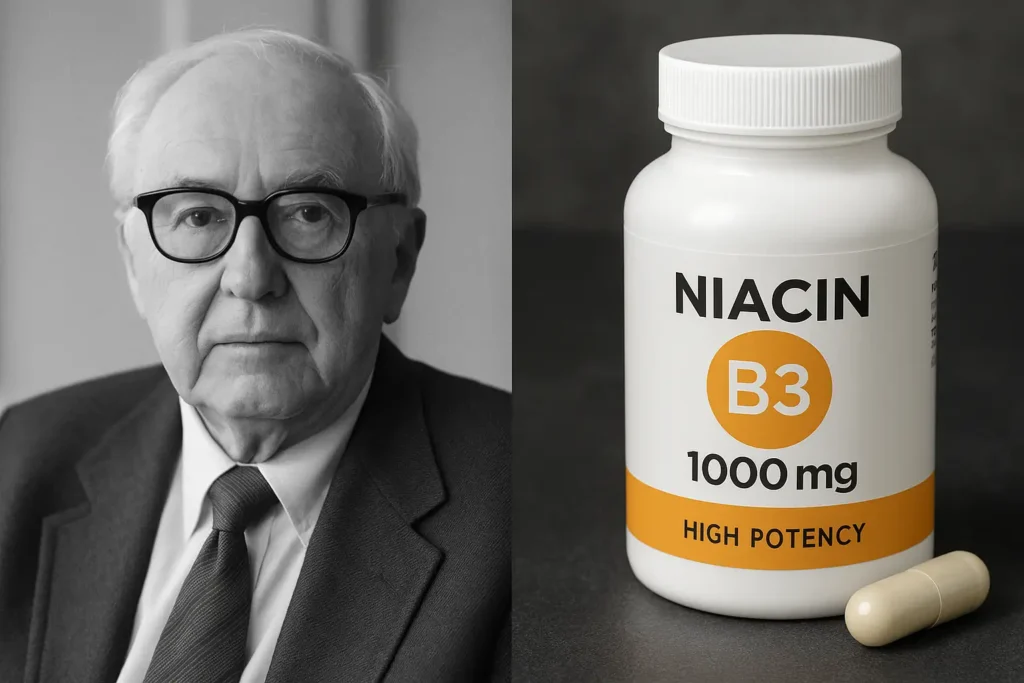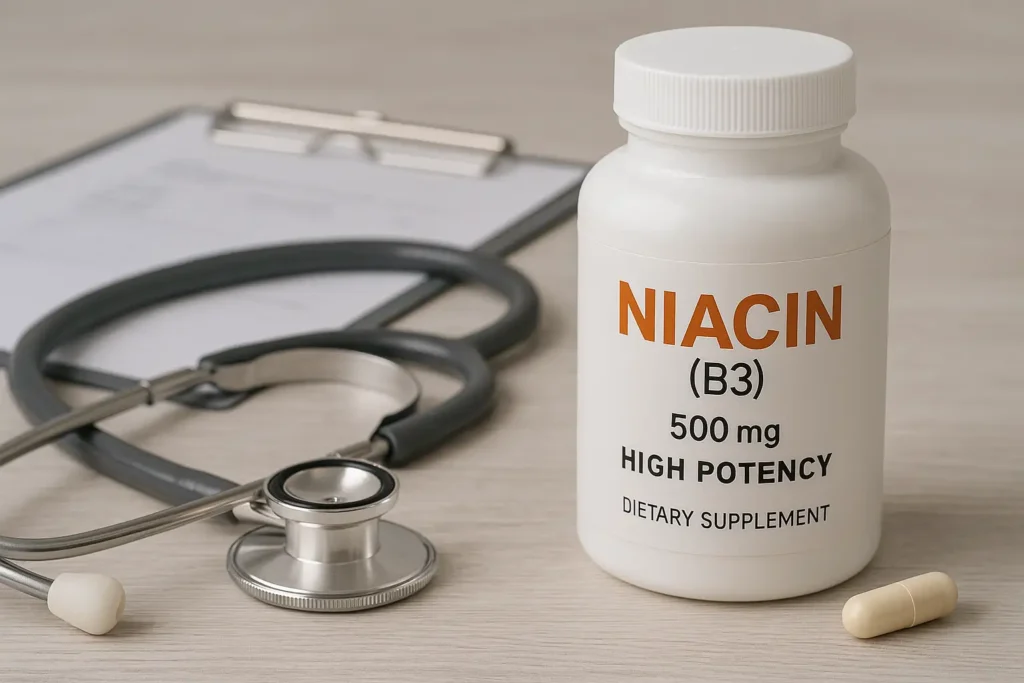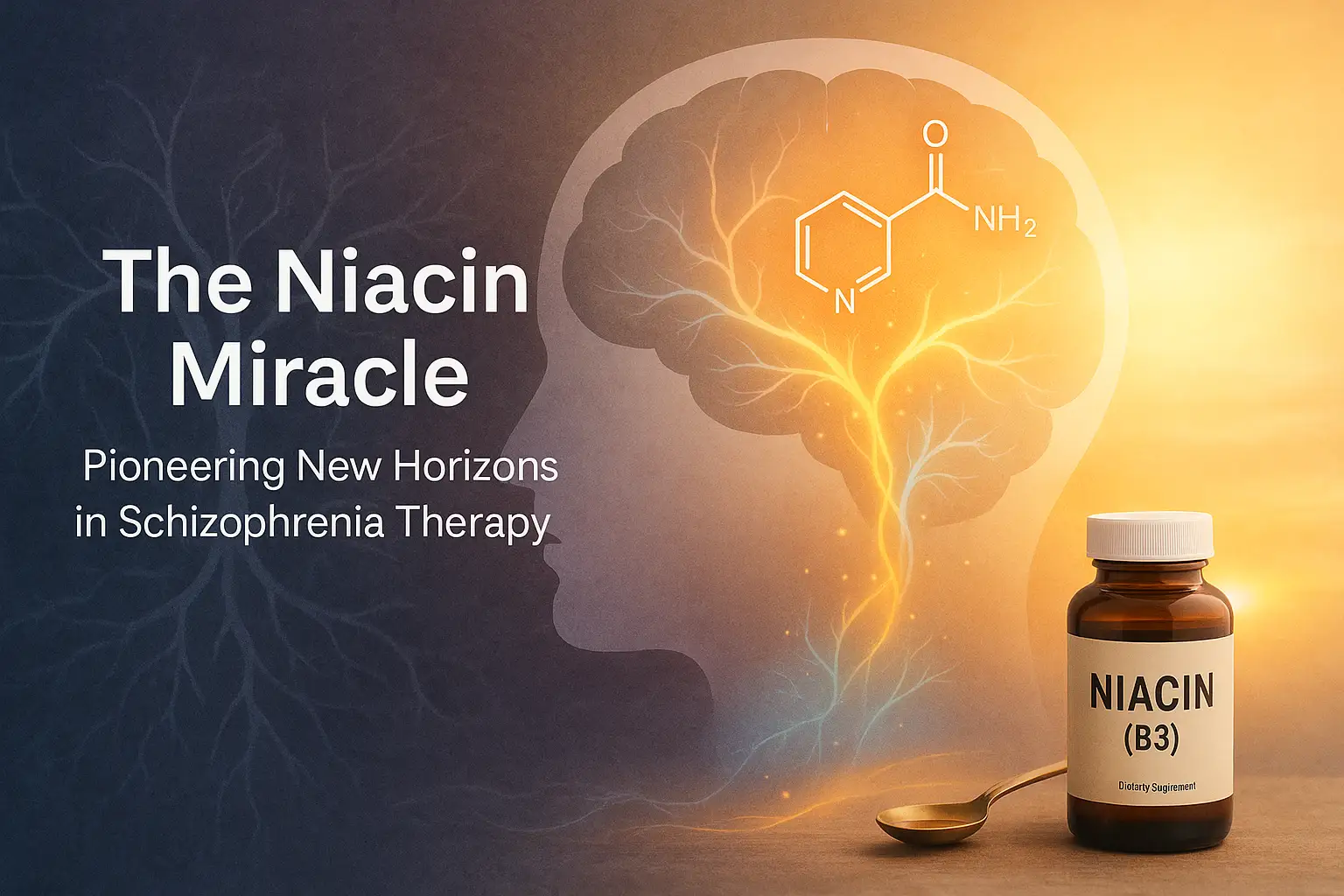Niacin, also known as Vitamin B3, is a crucial nutrient that plays a vital role in the human body. Primarily, it is involved in converting food into energy, maintaining healthy skin, and supporting the nervous system. Found in foods like poultry, fish, whole grains, and mushrooms, niacin is essential for overall health and wellbeing.
Schizophrenia is a complex and often debilitating mental health disorder characterized by distortions in thinking, perception, emotions, language, sense of self, and behavior. It typically manifests in late adolescence or early adulthood and is known for symptoms like hallucinations, delusions, and disordered thinking. The impact of schizophrenia is profound, affecting not just the individual but also their families and society. It challenges one’s ability to think clearly, manage emotions, make decisions, and relate to others.
The history of niacin in psychiatric treatment is both rich and intriguing, marking a significant journey in the understanding and management of mental health disorders.
Early Research and Use of Niacin in Mental Health The exploration of niacin’s role in mental health dates back to the mid-20th century. Initially, niacin was studied for its general health benefits, particularly in preventing pellagra, a disease caused by niacin deficiency characterized by dermatitis, diarrhea, and dementia. Researchers soon began to notice the implications of niacin deficiency on mental health, particularly its potential links to psychiatric conditions like depression and anxiety.
In the 1950s, a more direct connection between niacin and mental health was established. Scientists started exploring the use of niacin as a treatment for various psychiatric disorders, including schizophrenia. Early studies indicated that high doses of niacin could have a beneficial impact on the symptoms of schizophrenia, leading to further research in this area.
Pioneers in the Field and Key Studies One of the most notable pioneers in this field was Dr. Abram Hoffer, a Canadian psychiatrist who, along with his colleague Dr. Humphry Osmond, conducted groundbreaking studies on the use of niacin in schizophrenia treatment. They proposed the “adrenochrome hypothesis,” suggesting that schizophrenia was related to the production of adrenochrome, a neurotoxic substance, and that niacin could help mitigate its effects.
Their research in the 1950s and 1960s involved administering high doses of niacin to patients with schizophrenia. The results, though controversial and met with skepticism, showed significant improvements in some patients, particularly in reducing the severity of delusions and hallucinations.

Understanding Schizophrenia: Symptoms and Challenges
Schizophrenia is a complex and often misunderstood mental health disorder. It significantly impacts the lives of those affected and poses unique challenges in terms of diagnosis and treatment. A deeper understanding of schizophrenia is crucial for effective management and support.
Symptoms of Schizophrenia The symptoms of schizophrenia are typically divided into three categories:
- Positive Symptoms: These are symptoms that add to the person’s behavior. They include hallucinations (seeing or hearing things that aren’t there), delusions (false beliefs), thought disorders (unusual or dysfunctional ways of thinking), and movement disorders (agitated body movements).
- Negative Symptoms: These refer to elements that are taken away from the individual’s behavior, such as a reduction in emotional expression, lack of motivation, and reduced speaking.
- Cognitive Symptoms: These involve problems with thought processes, including issues with concentration, memory, and decision-making skills.
Diagnosis of Schizophrenia Diagnosing schizophrenia involves ruling out other medical conditions and considering the person’s medical history. It typically requires a comprehensive clinical evaluation by a psychiatrist, including interviews, medical exams, and, in some cases, neuroimaging or blood tests to rule out other conditions.
Common Treatments for Schizophrenia Treatment for schizophrenia is usually lifelong and often involves a combination of strategies:
- Medication: Antipsychotic medications are the cornerstone of schizophrenia treatment, helping to manage symptoms by affecting brain neurotransmitters.
- Psychotherapy: Various forms of psychotherapy, including cognitive-behavioral therapy (CBT), can be effective in managing symptoms and improving quality of life.
- Social and Vocational Skills Training: This can help patients with schizophrenia improve their communication, job, and social skills.
- Supportive Therapy: Regular follow-up with health care providers and support groups can provide necessary support and guidance.
The Concept of Niacin Mega Doses
In the context of psychiatric treatments, particularly for conditions like schizophrenia, the concept of niacin mega doses has garnered attention. Understanding what constitutes a mega dose of niacin, and how it compares to regular dietary recommendations, is crucial for a comprehensive view of this treatment approach.
What Constitutes a Mega Dose of Niacin
- A mega dose of niacin significantly exceeds the established daily dietary recommendations. While the Recommended Dietary Allowance (RDA) for niacin in adults ranges from 14 to 16 milligrams (mg) per day, mega doses used in clinical settings for certain conditions like schizophrenia can be as high as 3,000 to 9,000 mg per day, divided into several doses.
- These high doses are typically used under medical supervision and are a substantial increase over the amounts found in a standard diet or regular supplements.
Comparison with Regular Dietary Recommendations
- The RDA for niacin is set to prevent deficiency and maintain overall health, with a tolerable upper intake level (UL) of about 35 mg per day for adults, to avoid the risk of side effects.
- In contrast, niacin mega doses used in psychiatric treatments are well above the UL. The purpose of these high doses is to achieve certain therapeutic effects that are not obtainable with standard doses.
- It’s important to note that such high doses of niacin should only be taken under the guidance of a healthcare professional, as they can lead to significant side effects and require careful monitoring.
Scientific Basis: How Niacin Potentially Benefits Schizophrenia Patients
The use of niacin in treating schizophrenia is based on its unique interaction with the brain and body. This section delves into the biological mechanisms behind niacin’s potential benefits for schizophrenia patients and reviews relevant scientific studies and clinical trials.
Biological Mechanisms: How Niacin Interacts with the Brain and Body
- Niacin and Neurotransmitters: Niacin plays a role in the synthesis of several key neurotransmitters, including serotonin and dopamine, which are often imbalanced in schizophrenia. By influencing these neurotransmitter systems, niacin may help in alleviating some of the symptoms associated with schizophrenia.
- Anti-inflammatory Effects: Niacin has been observed to have anti-inflammatory properties. Since inflammation is thought to play a role in schizophrenia, niacin’s anti-inflammatory action might contribute to its therapeutic effects.
- Niacin Flush and Vasodilation: Niacin causes a “flush” due to vasodilation, the widening of blood vessels. This increased blood flow to the brain might have implications for improving cerebral function and potentially alleviating certain symptoms of schizophrenia.
Review of Scientific Studies and Clinical Trials
- Early Studies and Dr. Abram Hoffer’s Work: Some of the earliest studies conducted by Dr. Abram Hoffer in the 1950s suggested improvements in schizophrenia symptoms with high doses of niacin. However, these studies had methodological limitations and were met with skepticism.
- Recent Research: More recent studies have provided mixed results. Some small-scale studies and anecdotal reports suggest benefits, but larger, more rigorous clinical trials are needed to conclusively determine the efficacy of niacin in treating schizophrenia.
- Current Understanding and Recommendations: The scientific community currently views niacin as a potentially beneficial adjunct to traditional schizophrenia treatments rather than a standalone cure. Ongoing research continues to explore the role of niacin and other vitamins in mental health.

Case Studies: Niacin Mega Doses in Action
Examining real-life cases where niacin mega doses have been used to treat schizophrenia provides valuable insights into the practical applications and outcomes of this treatment approach. These case studies highlight individual experiences and help to understand the potential impact of niacin in schizophrenia management.
Real-life Examples and Outcomes from Niacin Treatment in Schizophrenia
- Early Case Studies by Dr. Abram Hoffer: One of the most significant contributors to this field, Dr. Hoffer documented several cases where high doses of niacin, often combined with other vitamins, were used to treat schizophrenia. In some instances, patients exhibited marked improvements in symptoms such as reduced hallucinations and delusions, improved mood, and enhanced cognitive function.
- Contemporary Examples: More recent case studies continue to explore the use of niacin. While results vary, some patients have shown improvement in symptoms, especially when niacin is used as part of a broader treatment plan that includes traditional medications and psychotherapy.
- Long-term Outcomes: Some case studies have followed patients over extended periods, noting improvements in social functioning and quality of life. However, the long-term efficacy and safety of niacin mega doses require more comprehensive research.
Challenges and Variabilities in Outcomes
- It’s important to note that responses to niacin treatment can vary significantly among individuals with schizophrenia, and not all patients experience positive outcomes.
- The effectiveness of niacin can also depend on various factors, including the stage and subtype of schizophrenia, the patient’s overall health, and concurrent use of other treatments.
Benefits of Niacin Treatment in Schizophrenia
Exploring the potential benefits of niacin treatment in schizophrenia is crucial to understanding why this approach has garnered interest. While responses vary, certain positive effects have been observed, contributing to success stories in some patients.
Potential Positive Effects
- Symptom Reduction: One of the most noted benefits of niacin treatment in schizophrenia is the reduction of core symptoms such as hallucinations, delusions, and severe mood swings. Some patients have reported a decrease in the intensity and frequency of these symptoms.
- Cognitive Improvements: There are indications that niacin can help improve cognitive functions in some schizophrenia patients, including better concentration, enhanced memory, and clearer thinking.
- Mood Stabilization: Niacin has been observed to help stabilize mood swings, which are often a challenge in schizophrenia. Patients sometimes experience improved emotional regulation and a decrease in depressive symptoms.
- Overall Well-being: Beyond specific symptom relief, niacin treatment has been associated with enhanced overall well-being and quality of life for some patients, possibly due to its role in general health maintenance.
Success Stories
- Individual success stories, although varied, provide anecdotal evidence of niacin’s potential benefits. These accounts often highlight significant improvements in daily functioning, relationships, and a return to more normal life routines.
- It is important to note that these success stories are individual cases and do not guarantee similar results for all schizophrenia patients.

Risks and Side Effects of Niacin Mega Doses
While niacin mega doses have shown potential in treating conditions like schizophrenia, it’s crucial to be aware of the possible risks and side effects associated with this therapy. Understanding these risks is key to ensuring safe and informed treatment decisions.
Possible Risks and Side Effects
- Niacin Flush: One of the most common side effects of high-dose niacin is the “niacin flush,” characterized by skin flushing, warmth, itching, or tingling. This reaction is caused by the dilation of blood vessels and typically occurs shortly after taking niacin.
- Gastrointestinal Issues: Niacin can cause gastrointestinal distress, including nausea, vomiting, and diarrhea, particularly at high doses.
- Liver Toxicity: High doses of niacin can lead to liver toxicity, one of the most serious risks. This can manifest as elevated liver enzymes, jaundice, or more severe liver damage.
- Altered Blood Sugar Levels: Niacin therapy can impact blood sugar control, making it a concern for individuals with diabetes or those at risk of diabetes.
- Increased Risk of Bleeding: Niacin can interfere with blood clotting, thereby increasing the risk of bleeding, especially in individuals on blood-thinning medications.
Contraindications of High-Dose Niacin Therapy
- Individuals with a history of liver disease, peptic ulcers, or certain forms of bleeding disorders should avoid high doses of niacin.
- Pregnant or breastfeeding women should be cautious and consult healthcare professionals before considering niacin therapy, as the safety of high doses in these groups is not well-established.
Niacin Therapy: A Comparison with Traditional Schizophrenia Treatments
Niacin therapy, especially in mega doses, presents a distinct approach to treating schizophrenia, differing significantly from conventional treatments. Understanding how niacin therapy compares with traditional methods is essential for a holistic view of schizophrenia management.
Comparison with Conventional Treatments
- Mechanism of Action: Traditional schizophrenia treatments primarily involve antipsychotic medications that target neurotransmitter pathways, particularly dopamine. Niacin therapy, on the other hand, is based on its role in neurotransmitter synthesis and possible effects on brain inflammation, offering a different mechanism of action.
- Side Effects Profile: Antipsychotic medications often come with a range of side effects, including weight gain, drowsiness, and movement disorders. Niacin therapy, while having its own set of potential side effects like flushing and liver toxicity, presents a different side effect profile.
- Long-term Effects: The long-term effects of antipsychotics can include metabolic changes and tardive dyskinesia, a condition affecting movement. The long-term impacts of niacin therapy are less understood and require more research.
- Efficacy: While traditional antipsychotics are the established first-line treatment for schizophrenia with proven efficacy, niacin therapy’s effectiveness is still being explored and is currently considered more experimental.
Patient and Medical Community Perspectives on Niacin Therapy
The perspectives of patients and the medical community on niacin therapy, especially for schizophrenia, offer valuable insights into its acceptance, efficacy, and potential role in treatment. These testimonials and opinions reflect the diverse attitudes towards this unconventional treatment approach.
Patient Testimonials
- Varied Experiences: Some patients report significant improvements in their symptoms of schizophrenia after starting niacin therapy, describing it as life-changing. These positive experiences often highlight reduced hallucinations, clearer thinking, and improved emotional stability.
- Skepticism and Caution: Conversely, other patients express skepticism or report no significant changes. Concerns about side effects and the unconventional nature of the therapy also play a role in their cautious approach.
- Hope and Advocacy: Many patients view niacin therapy as a source of hope, particularly those who have not found relief with traditional treatments. Some become advocates, sharing their experiences to raise awareness about alternative treatment options.
Medical Community Opinions
- Debate and Divergence: Within the medical community, opinions on niacin therapy are divided. While some practitioners are open to exploring it as an adjunct treatment, others remain skeptical, citing a lack of robust scientific evidence.
- Research and Clinical Trials: Researchers and clinicians emphasize the need for more comprehensive studies to ascertain the efficacy, safety, and appropriate dosages of niacin in treating schizophrenia.
- Integrative Approaches: There is a growing interest in integrative medicine, combining conventional treatments with alternatives like niacin therapy, especially in cases where patients have not responded well to standard medications.
Practical Considerations: Administering Niacin for Schizophrenia
Administering niacin for schizophrenia involves several practical considerations, including guidelines on dosages, administration methods, and monitoring. These factors are crucial for ensuring the therapy’s effectiveness and patient safety.
Guidelines on Administration and Dosages
- Starting Dose: The initiation of niacin therapy typically involves a lower dose, which is gradually increased. Starting with a lower dose helps to minimize side effects like the niacin flush.
- Mega Doses: For schizophrenia treatment, the doses used are often much higher than the daily recommended intake. Dosages can range from 1,000 to 3,000 mg per day, divided into multiple doses. However, the exact dosage should be determined by a healthcare provider based on individual patient needs.
- Method of Administration: Niacin is available in various forms, including tablets, capsules, and extended-release formulations. The choice depends on patient preference, tolerability, and medical advice.
Monitoring and Adjustments
- Regular Monitoring: Patients on niacin therapy require regular monitoring, especially for liver function, lipid levels, and blood glucose, as high doses of niacin can impact these parameters.
- Managing Side Effects: Monitoring also helps in managing side effects. If adverse reactions are significant, the dosage of niacin may be adjusted, or the treatment method may be re-evaluated.
- Patient Response: Regular assessments of the patient’s psychiatric symptoms are necessary to evaluate the effectiveness of niacin therapy and make necessary adjustments.
Conclusion and Recommendations
As we explore the potential of niacin mega doses for treating schizophrenia, it’s essential to sum up the current state of knowledge and offer recommendations for patients and healthcare providers navigating this complex area.
Summing Up the Current State of Knowledge
- Emerging Therapy: Niacin therapy, particularly in mega doses, is an emerging area in the treatment of schizophrenia. While early research and anecdotal evidence suggest potential benefits, more comprehensive and systematic scientific studies are needed.
- Varied Responses: The response to niacin therapy can vary significantly among individuals. For some, it may offer notable improvements in symptoms, while for others, the effects may be minimal or accompanied by significant side effects.
- Balancing Risks and Benefits: Understanding and balancing the risks and benefits of niacin therapy is crucial. This includes careful consideration of side effects, particularly at higher doses, and the importance of regular monitoring.
Recommendations for Patients and Healthcare Providers
- Informed Decisions: Patients considering niacin therapy should do so under the guidance of a healthcare provider and after thorough discussions about the potential risks and benefits.
- Monitoring and Adjustments: Continuous monitoring of the patient’s physical and mental health is essential when administering niacin, with adjustments made as necessary.
- Collaborative Approach: A collaborative approach involving psychiatrists, general practitioners, and nutritionists can provide a comprehensive treatment plan that includes traditional medications, niacin therapy, psychotherapy, and lifestyle adjustments.
- Ongoing Research and Learning: Healthcare providers should stay informed about the latest research and developments in niacin therapy for schizophrenia to provide up-to-date care.
Resources
- Academic Journals: Search for journals like “American Journal of Psychiatry,” “Journal of Clinical Psychiatry,” and “Journal of Nutritional Biochemistry” through academic databases like Google Scholar, JSTOR, or directly on the journals’ websites.
- Books: Look for books such as “Niacin: The Real Story” by Dr. Abram Hoffer on online bookstores like Amazon, Barnes & Noble, or your local library’s online catalog.
- Medical Websites and Databases: Visit websites like PubMed (pubmed.ncbi.nlm.nih.gov), WebMD (www.webmd.com), and the Mayo Clinic (www.mayoclinic.org) for articles and research summaries.
- Conferences and Symposia: Check the websites of medical conferences or organizations related to psychiatry and nutrition for any available recordings or proceedings.
- Patient Advocacy Groups and Forums: Websites of mental health organizations like NAMI (National Alliance on Mental Illness) at www.nami.org or Mental Health America at www.mhanational.org often have resources and discussion forums.
Disclaimer:
It’s important to note that while these resources can provide valuable information, they should not replace professional medical advice. Always consult with healthcare professionals before making any changes to treatment plans.
In conclusion, a variety of resources are available for those interested in exploring niacin therapy for schizophrenia in more depth. From academic studies to patient testimonials, these materials can help deepen your understanding and inform discussions with healthcare providers about this potential treatment option.


0 thoughts on “The Niacin Miracle: Pioneering New Horizons in Schizophrenia Therapy”